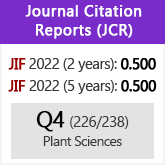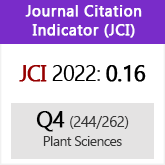Diversity of Xanthoparmelia (Parmeliaceae) species in Mexican xerophytic scrub vegetation, evidenced by molecular, morphological and chemistry data
DOI:
https://doi.org/10.3989/ajbm.2564Keywords:
Cryptic species, biodiversity, secondary metabolites, lichens, MexicoAbstract
The genus Xanthoparmelia is the largest genus of lichen- forming fungi with about 800 species worldwide. Xanthoparmelia is also common in the deserts of central Mexico, but only a few molecular studies exist on its species’ diversity in this region. In this study, we sampled 38 Xanthoparmelia species from around the world including species from the xerophytic scrubs of central Mexico to assess the diversity using an integrative approach. Molecular phylogenetic analyses were performed using a combination of the ITS, mtSSU and nuLSU genetic markers. We evaluated our phylogenetic results in a context of traditional morphological and chemical characters. The combined evidence of molecular, morphological, and chemical data identified a total of 18 Xanthoparmelia species-level lineages occurring in central Mexico. However, numerous traditionally circumscribed species did not form monophyletic groups in the molecular phylogenetic reconstructions. This conflict indicates that taxonomy and species delimitation in the genus Xanthoparmelia requires revision and emphasizes the importance of molecular evidence for more robust species delimitations in this genus.
Downloads
References
Arup U., Ekman S., Lindblom L. & Mattsson J-E. 1993. High performance thin layer chromatography (HPTLC), an improved technique for screening lichen substances. Lichenologist 25: 61-71.
Autumn K., Barcenas-Pe a A., Kish-Levine S., Huang J-P & Lumbsch T.H. 2020. Repeated colonization between arid and seasonal wet habitats, frequent transition among substrate preferences, and chemical diversity in Western Australian Xanthoparmelia lichens. Frontiers in Ecology and Evolution 8: 129.
Barcenas-Pe a A., Leavitt S.D., Huang J.P., Grewe F. & Lumbsch H.T. 2018. Phylogenetic study and taxonomic revision of the Xanthoparmelia mexicana group, including the description of a new species (Parmeliaceae, Ascomycota). MycoKeys 40: 13-28. https://doi.org/10.3897/mycokeys.40.26724 PMid:30271262 PMCid:PMC6160798
Blanco O., Crespo A., Elix J.A., Hawksworth D.L. & Lumbsch, H.T. 2004. A molecular phylogeny and a new classification of parmelioid lichens containing Xanthoparmelia-type lichenan (Ascomycota: Lecanorales). Taxon 53: 959-975.
Brown J. 2001. Mammals on mountainsides: elevational pattern of diversity. Global Ecology and Biogeography 10: 101-109. https://doi.org/10.1046/j.1466-822x.2001.00228.x
Castresana J. 2000. Selection of conserved blocks from multiple alignments for their use in phylogenetic analysis. Molecular Biology and Evolution 17: 540-552. https://doi.org/10.1093/oxfordjournals.molbev.a026334 PMid:10742046
Culberson C. & Johnson A. 1982. Substitution of methyl tert.-butyl ether for diethyl ether in standardized thin layer chromatographic method for lichen products. Journal of Chromatography B 238: 438-487. https://doi.org/10.1016/S0021-9673(00)81336-9
Culberson C., Nash T.H. III & Johnson A. 1979. 3-α-hydroxibarbatic acid, a new depside in chemosyndrome of some Xanthoparmeliae with α-orcinol depsides. Bryologist 82: 154-161. https://doi.org/10.2307/3242074
Darriba D., Taboada G.L., Doallo R. & Posada D. 2012. jModelTest 2: more models, new heuristics and parallel computing. Nature Methods 9: 772. Elix J.A. 1994. Xanthoparmelia. Flora of Australia 55: 201-308. https://doi.org/10.1038/nmeth.2109 PMid:22847109 PMCid:PMC4594756
Feige G.B. & Lumbsch H.T. 1995. Some types of chemical variation in lichens. Cryptogamic Botany 5: 31-35. Fischer A.G. 1960. Latitudinal variations in organic diversity. Evolution 14: 64-81. https://doi.org/10.1111/j.1558-5646.1960.tb03057.x
Gardes M. & Bruns T. 1993. ITS primers with enhanced specificity for basidiomycetes-Application to the identification of mycorrhizae and rusts. Molecular Ecology 2: 113-118. https://doi.org/10.1111/j.1365-294X.1993.tb00005.x PMid:8180733
Gelman A. & Rubin D.B. 1992. Inference from iterative simulation using multiple sequences. Statistical Science 7: 457-511.
Grewe F., Huang J.P., Leavitt S.D. & Lumbsch H.T. 2017. Referencebased RADseq resolves robust relationships among closely related species of lichen-forming fungi using metagenomic DNA. Scientific Reports 7: 9884.
Grewe F., Lagostina E., Wu H., Printzen C. & Lumbsch H.T. 2018. Population genomic analyses of RAD sequences resolves the phylogenetic relationship of the lichen-forming fungal species Usnea antarctica and Usnea aurantiacoatra. Mycokeys 43: 91-113. https://doi.org/10.3897/mycokeys.43.29093 PMid:30588165 PMCid:PMC6300515
Guindon S. & Gascuel O. 2003. A simple, fast and accurate method to estimate large phylogenies by maximum-likelihood. Systematic Biology 52: 696-704. https://doi.org/10.1080/10635150390235520 PMid:14530136
Hale Jr. M.E. 1990. A synopsis of the lichen genus Xanthoparmelia (Vainio) Hale (Ascomycotina, Parmeliaceae). Smithsonian Contributions to Botany 74: 1-250. https://doi.org/10.5479/si.0081024X.74
Huelsenbeck J.P. & Ronquist F. 2001. MRBAYES: Bayesian inference of phylogenetic trees. Bioinformatics 17: 754-755.
Jaklitsch W.M., Baral H.O., Lücking R. & Lumbsch H.T. 2016. Ascomycota. In Frey W. (ed.), Syllabus of Plant Families - Adolf Engler's Syllabus der Pflanzenfamilien: 1-150. Stuttgart, Gebr. Borntraeger Verlagsbuchhandlung.
Katoh K. & Standley D.M. 2013. MAFFT multiple sequence alignment software version 7: improvements in performance and usability. Molecular Biology and Evolution 30: 772-780.
Kraichak E., Divakar P.K., Crespo A., Leavitt S.D., Nelsen M.P., Lücking R. & Lumbsch H.T. 2015. A tale of two hyper-diversities: diversification dynamics of the two largest families of lichenized fungi. Scientific Reports 5: e10028.
Leavitt S.D., Johnson L.A., Goward T. & St. Clair L.L. 2011. Species delimitation in taxonomically difficult lichen-forming fungi: an example from morphologically and chemically diverse Xanthoparmelia (Parmeliaceae) in North America. Molecular Phylogenetics and Evolution 60: 317-332.
Leavitt S.D., Kirika P.M., Amo de Paz G., Huang J.P., Hur J.S., Elix J.A., Grewe F., Divakar P.K. & Lumbsch H.T. 2018. Assessing phylogeny and historical biogeography of the largest genus in lichen-forming fungi, Xanthoparmelia (Parmeliaceae, Ascomycota). Lichenologist 50: 299-312. https://doi.org/10.1017/S0024282918000233
Leavitt S.D., Lumbsch H.T., Stenroos S. & St Clair L.L. 2013. Pleistocene speciation in North American lichenized fungi and the impact of alternative species circumscriptions and rates of molecular evolution on divergence estimates. Plos One 8: e85240.
Lücking R., Rivas Plata E., Chaves J.L., Uma a L. & Sipman H.J.M. 2009. How many tropical lichens are there. . . really? Bibliotheca Lichenologica 100: 399-418.
Lücking R., Villase or J.L., Herrera-Campos M.A., P rez-P rez R.M., Egan S.R., Esslinger H.L. & Nash III T.H. 2016. Phylogenetic structure of metacommunities in Mexican Parmeliaceae (lichenized Ascomycota: Lecanorales). Bibliotheca Lichenologica 110: 27-54.
Lumbsch H.T. 1998a. The use of metabolic data in lichenology at the species and subspecific levels. Lichenologist 30: 357-367.
Lumbsch H.T. 1998b. The taxonomic use of metabolic data in lichen-forming fungi. In Frisvad J.C., Bridge P.D. & Arora D.K. (eds.), Chemical Fungal Taxonomy: 345-387. Marcel Dekker, New York.
Lumbsch H.T. 2002. Analysis of phenolic products in lichens for identification and taxonomy. In Kranner I., Beckett R. & Varma A. (eds.), Protocols in Lichenology Culturing, biochemistry, ecophysiology and use in biomonitoring: 281-295. Springer, Berlin.
Mangold A., Mart n M.P., Lücking R. & Lumbsch H.T. 2008. Molecular phylogeny suggests synonymy of Thelotremataceae within Graphidaceae (Ascomycota: Ostropales). Taxon 57: 476-486.
Miller M.A., Pfeifer W. & Schwartz T. 2010. CIPRES Science Gateway survey. Webside: http://www.phylo.org [accessed: 24 Mar. 2020]
Mittermeier R. 1988. Primate diversity and the tropical forest. Case studies from Brazil and Madagascar and the importance of the megadiversity countries. In Wilson E.O. (ed.), Biodiversity: 145-154. National Academy Press, Washington.
Myers N., Mittermeier R.A., Mittermeier C.G., da Fonseca G.A.B. & Kent J. 2000. Biodiversity hotspots for conservation priorities. Nature 403: 853-858.
Nash III T.H. & Elix J.A. 2004. Xanthoparmelia. In Nash III T.H., Ryan B.D., Diederich P., Gries C. & Bungartz F. (eds.), Lichen Flora of the Greater Sonoran Desert Region vol. 2: 566-605. Lichens Unlimited, Arizona State University, Tempe.
Nash III T.H., Herrera-Campos M.A. & Elix J.A. 2004. Preliminary treatment of Xanthoparmelia for Mexico. Symbolae Botanicae Upsaliensis 34: 289-326.
Nash III T.H., Herrera-Campos M.A., Esslinger T.L. & Elix J.A. 2016. Xanthoparmelia in Mexico. Bibliotheca Lichenologica 110: 621-641. Orange A., James P.W. & White F.J. 2010. Microchemical methods for the identification of lichens, second edition with additions and corrections. British Lichen Society, London.
Pino-Bodas R., Rosa Burgaz A., Martin M.P. & Lumbsch H.T. 2012. Species delimitations in the Cladonia cariosa group (Cladoniaceae, Ascomycota). Lichenologist 44: 121-135. https://doi.org/10.1017/S002428291100065X
Ramamoorthy T.P., Bye R., Lot A. & Fa J. 1993. Biological Diversity of Mexico: Origins and Distribution. Oxford University Press, Oxford.
Rambaut A. 2014. FigTree 1.2.2. Webside: http://tree.bio.ed.ac.uk/software/fgtree/ [accessed: 24 Mar. 2020].
Ronquist F. & Huelsenbeck J.P. 2003. MrBayes 3: Bayesian phylogenetic inference under mixed models. Bioinformatics 19: 1572-1574.
Rozzi R., Armesto J.J., Goffinet B., Buck W., Massardo F., Silander J., Arroyo M.K.T., Russell S., Anderson C.B., Cavieres L.A. & Callicott J.B. 2008. Changing lenses to assess biodiversity: patterns of species richness in sub-Antarctic plants and implications for global conservation. Frontiers in Ecology and the Environment 6: 131-137. https://doi.org/10.1890/070020
Rzedowski J. 1978. Vegetaci n de M xico. Editoral Limusa, M xico. Stamatakis A. 2014. RAxML Version 8: A tool for phylogenetic analysis and post-analysis of large phylogenies. Bioinformatics 30: 1312-1313. https://doi.org/10.1093/bioinformatics/btu033 PMid:24451623 PMCid:PMC3998144
Thell A., Crespo A., Divakar P.K., K rnefelt I., Leavitt S.D., Lumbsch H.T. & Seaward M.R.D. 2012. A review of the lichen family Parmeliaceae - history, phylogeny and current taxonomy. Nordic Journal of Botany 30: 641-664. https://doi.org/10.1111/j.1756-1051.2012.00008.x
Vaidya G., Lohman D.J. & Meier R. 2011. SequenceMatrix: concatenation software for the fast assembly of multi-gene datasets with character set and codon information. Cladistics 27: 171-180. https://doi.org/10.1111/j.1096-0031.2010.00329.x
Vilgalys R. & Hester M. 1990. Rapid genetic identification and mapping of enzymatically amplified ribosomal DNA from several Cryptococcus species. Journal of Bacteriology 172: 4238-4246. https://doi.org/10.1128/jb.172.8.4238-4246.1990 PMid:2376561 PMCid:PMC213247
White T.J., Bruns T.D., Lee S. & Taylor J. 1990. Amplification and direct sequencing of fungal ribosomal RNA genes for phylogenetics. In Innis M.A., Gelfand D.H., Sninsky J.J. & White T.J. (eds.), PCR Protocols: 315-322. Academic Press, San Diego. https://doi.org/10.1016/B978-0-12-372180-8.50042-1 PMid:1696192
Zoller S., Scheidegger C. & Sperisen C. 1999. PCR primers for the amplication of mitochondrial small subunit ribosomal DNA of lichenforming ascomycetes. Lichenologist 31: 511-516. https://doi.org/10.1006/lich.1999.0220
Published
How to Cite
Issue
Section
License
Copyright (c) 2021 Consejo Superior de Investigaciones Científicas (CSIC)

This work is licensed under a Creative Commons Attribution 4.0 International License.
© CSIC. Manuscripts published in both the printed and online versions of this Journal are the property of Consejo Superior de Investigaciones Científicas, and quoting this source is a requirement for any partial or full reproduction.All contents of this electronic edition, except where otherwise noted, are distributed under a “Creative Commons Attribution 4.0 International” (CC BY 4.0) License. You may read here the basic information and the legal text of the license. The indication of the CC BY 4.0 License must be expressly stated in this way when necessary.
Self-archiving in repositories, personal webpages or similar, of any version other than the published by the Editor, is not allowed.

















